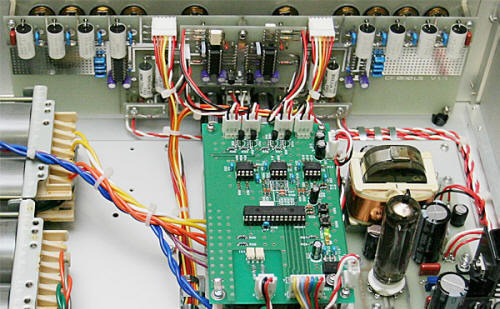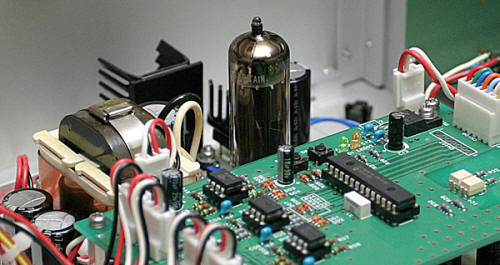
You are reading the older HTML site
Positive Feedback ISSUE
41january/february 2009
concert fidelity
CF-080 linestage
as reviewed by Mike Wechsberg

|
MIKE WECHSBERG'S SYSTEM
LOUDSPEAKERS
ELECTRONICS
SOURCES
CABLES
|
This was originally going to be a review of both the Concert Fidelity CF-080 hybrid line stage preamp and the Silicon Arts Design ZL-120 solid-state monoblock amplifiers, both of which are designed by Masataka Tsuda in Japan, but the preamp is so good I decided it warranted its own separate review. Additionally, the distributor alerted me that the price is going up soon for both units due to the strong yen, so by splitting the reviews I can get this one out faster so anyone contemplating a preamp purchase might be able to find one at the lower price.
My first impression upon opening the CF-080 box was decidedly negative. This is an expensive preamp yet the buyer has to partially assemble the thing like a kit and with limited instructions. First, the chassis has no feet—a set of plastic feet are provided in a separate bag but these looked pretty perfunctory. I ended up skipping these and using a set of Vibrapod feet I had handy. Concert Fidelity encourages experimentation with different isolation feet, which explains why the ones they provide are not installed.
Next, the EZ81/6CA4 rectifier tube needs to be installed inside the chassis, which first requires opening 14 screws. The small screws have a hex head and no Allen wrench is provided! After rummaging through my tools I managed to find a wrench that fit and worked my way through the screws to open the top panel. Looking inside at the quality parts and hand workmanship improved my mood considerably, but when I went to the bag of tubes supplied with the preamp I had to guess which tube was the rectifier tube. The box was unmarked and the tube itself was not marked as a 6CA4. The review sample was supplied with two extra sets of audio tubes that added to the confusion, but it would still be helpful if the tube boxes were marked. After figuring out the rectifier tube and re-installing the 14 screws the time came to install the two 12AU7 audio tubes. Sockets for these tubes are readily accessible in the back of the chassis to facilitate tube rolling. The instruction sheet that came with the preamp said the unit was run in for 100 hours with Pinnacle 13D5A tubes. These at least were pretty easy to identify and install. Finally, before mounting the unit onto my audio shelf I had to rummage for a power cord as one was not supplied (I believe sale units do come with a power cord, but the manufacturer encourages the user to experiment with various power cords). I used an inexpensive Shunyata power cord I had on hand and plugged it into my PS Audio Power Plant Premier.


Let me first describe the CF-080 before talking about its sound. This line stage is a hybrid design. It uses a solid-state analog switch for input switching and an analog solid-state volume control selected for its sonic quality and tracking accuracy. The preamp gain is provided by one 12AU7 tube in cascode mode per channel. I already mentioned that the power supply is designed around a tube rectifier. A major philosophy at Concert Fidelity is the use of short signal paths (Concert Fidelity calls this Direct Signal Path Technology). The 12AU7 tubes are on the back panel virtually bonded to the output connectors. There are four inputs and one-pair of outputs plus a record output - all single-ended. The input switch, volume control, and gain stages are all assembled onto a circuit board along the back of the preamp resulting in a signal path of only 4-inches from input to output! The volume is controlled by a microprocessor (not on the rear panel) and proprietary software that allows for remote control with digital volume readout on the front panel.

The rear panel has the power on-off switch and a standby-operate toggle. In normal operation the power switch is left turned on which keeps the solid-state circuits and rectifier tube energized. The standby-operate switch is used to fully power up the audio tubes, which come alive after about a 30-second delay. The unit has a 100 kOhm input impedance, a relatively low gain of 6 dB, and inverts phase (something to keep in mind when hooking up the loudspeakers). The front panel has four toggle switches and indicator lights to select among the four inputs, and a fifth toggle for the mute function. These switches are very small so the dominant feature of the front panel is the rotary volume knob and digital volume display. Notably there is no balance control, this in keeping with the simple circuitry philosophy of the company. In listening the volume control seemed to be perfectly balanced but this does not allow for the occasional recording that needs a bit of left-right adjustment. The world's most basic remote control comes with the CF-080. It is a small rectangular aluminum block with just one red and one black push button. Pressing the red button raises the volume one notch, and the black lowers the volume by the same amount. Holding down either button does not continuously vary the volume so you have to keep pressing the buttons. I can live with not having input selection on the remote, but I wish another button had been added for the mute function.
The casework on the CF-080 is good quality but lacks the bling factor of many comparably priced units. The front panel however is very elegant in an understated way. It does not cry out "expensive" but it does say "I am a quality product". Overall the CF-080 gives the impression of good engineering sense and careful layout, where the cost has gone into the audio circuitry and not on any 'wasted' extravagance.
I substituted the CF-080 in my system for the Audible Illusions 3A preamp I've had for many years. Initially I kept my reference Krell KAV-250 amplifier in the system so I could best evaluate the sound of the preamp alone. Speakers were the very dynamic Wilson Cubs. Since the CF-080 did not have a second set of preamp outputs like the Audible Illusions, I decided to do all my listening without the Velodyne subwoofer usually used with the Wilsons. This did not prove to be a problem.
I started with the Pinnacle 13D5A tubes, which is the tube type the preamp is normally shipped with. Although I use tubes, I am not a tube fascista, but from some limited web research it seems these are NOS tubes manufactured by Toshiba in Japan. After a couple of hours of warm up the sound I heard completely bowled me over. It was startling in transparency and dynamic range with the best low frequency transients I have ever heard. The first few recordings I played featured well recorded vocals by Aaron Neville, Johnny Cash, Eva Cassidy, Allison Krauss and others. Every single song was presented as if I was hearing it for the first time. The CF-080 has a way of drawing you into the music emotionally, which is the holy grail of audio—if you ask me. Some of the performances were quite spooky real. The sound was full-bodied, though it lacked that midrange bloom of some other tube preamps. This I find to be more of a coloration than truthfulness to the music. In fact, I couldn't tell this preamp had tubes in it except that it sounded so damn good. It was clean and clear top to bottom with absolutely no strain anywhere in the frequency spectrum. The soundstage was broad, especially on some of those RCA and Mercury recordings we all love so much, with plenty of air around the instruments. I especially enjoyed small-scale, intimate classical recordings, not usually my favorite, but with the CF-080 these recordings became much more involving and the artistry of the performers could be readily appreciated.
The low end of the CF-080 is great, with especially tuneful and nuanced bass notes in addition to the fantastic transient performance I already mentioned. Because my Wilson Cubs don't extend below 45Hz or so I can't vouch for the extreme low end, but subjectively the CF-080 seemed to extend the bottom end of my system into the upper 30Hz range (at least with the stock Pinnacle tubes; low end extension was not quite as evident with the other tubes I tried). The midrange is very flat with tremendous transparency. The midrange sound was neither too warm nor too thin, but just right. Male and female vocals, as well as piano, were reproduced with a lifelike flair. Images were rock solid and each vocalist or instrument stood out in its own individual space. This characteristic was vastly superior to the Audible Illusions preamp, which is no slouch in this area itself.
The high end is chameleon-like, sounding different depending on the recording. In other words, the CF-080 threw no veils between the listener and the music. It sometimes sounded harsh when the recording did and at other times it was utterly beautiful when such sound was captured in the recording. The clarity and transparency of the CF-090 allowed me to hear some wonderful details that I missed with other equipment. Nevertheless I felt I was not hearing the best the preamp could offer in the highs due to other limitations in my system.
Since Concert Fidelity supplied a couple of other tube types, and the tubes can be replaced easily from the rear panel, I decided to try some tube rolling to see if I could get even better sound out of this beauty. The second set I tried were a pair of Brimar CV4068 tubes. These tubes shifted the frequency balance a bit resulting in less bass with a bit more treble. I suspect the response through these tubes was flatter than through the Pinnacle set, but no less enjoyable. Articulation was slightly improved on voices and there was a subtle improvement in the sound of cymbals and bells and such. On the other hand the low frequency slam backed off a bit which I missed, especially sans my sub.
The third set of 12AU7s I tried were in an unmarked box but were identified by Concert Fidelity as Mullard CV4003 made in about 1984. These tubes added further refinement to the high end sound of the CF-080 and fleshed out the back corners of the soundstage on various recordings. However, they were a little thinner sounding than the original Pinnacle tubes. I decided to conduct the remainder of my listening with the original Pinnacle tubes.
Overall the CF-080 made beautiful music. Especially notable are its speed and fast transient response over the whole frequency range, and its transparency. These are essential to making an emotional connection with the music and are no doubt a result of the specific goals of the short signal path philosophy of the designer. I'd have to rate the execution of that philosophy as a success. I didn't play too many mediocre recordings through this line stage, but no matter what I played the CF-080 seemed to find the best in each recording to allow the listener to connect with the music. It literally removed veils in many recordings and left just the pure sound we audiophiles are always looking for in our systems. Slight adjustments in tonality are possible with different tubes, power cords, or isolation feet but I don't think you can spoil the pure nature of this fine component. No wonder such notable audiophiles as Steve Hoffman and Dick Olsher own this preamp. It is truly a wonder and certainly among the best out there. It's unfortunate that the strong yen has driven the price of the CF-080 so high as it will deter some of you out there from taking the plunge, but if you can, I strongly encourage you to give this one a listen. You won't regret one minute of the experience. Mike Wechsberg
CF-080 Linestage
Retail: $18,000 (soon to be raised to $20,000)
Concert Fidelity
web address:
http://www.concertfidelity.jp

